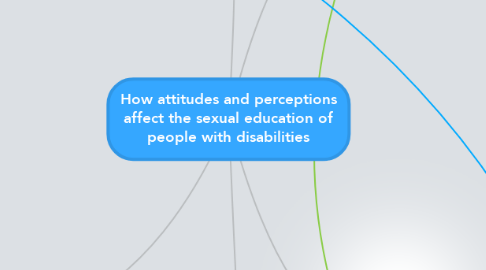
1. Heteronormative slant to most sex education
1.1. disability seen as sufficiently 'different'
1.2. gender identities and sexual orientations other than heteronormative rendered invisible
1.2.1. (Lofgren-Martenson, 2009), (Abbott & Howarth, 2005)
1.3. "socio-cultural barriers may be more disabling than the physical impairment itself" (Esmail, et al., 2010, p.1148) & "cultural ideas of attractiveness may hinder the sexual expression of disabled people" (de Boer, 2015, p.66)
1.3.1. (Esmail, et al., 2010), (de Boer, 2015)
1.4. "Individuals are not taught how to approach or develop their sexuality regardless of ability or disability [in North America]" (Esmail, et al., 2010, p.1152)
1.5. not providing sex ed systematically and purposefully makes people with disabilities 'different'. Oppresses and controls them
2. Alignment with general education sex ed
2.1. same access?
2.1.1. (Lofgren-Martenson, 2012)
2.1.2. (East & Orchard, 2014, p.335)
2.2. general population learns about sex from parents & friends but people with disabilities generally do not
2.2.1. (Esmail, 2010, p.1152)
2.3. directing sex education for people with disabilities towards the general population may reduce stigma and encourage people to see people with disabilities as sexual beings not as 'different'
2.4. Effective social skills program that links with sex education for people with ID
2.4.1. (Hayashi, et al., 2011) - good example of program used
2.4.2. skills taught by new person of same generation as opposed to teacher/facilitator they are used to. Therefore need to USE skills and can generalise more easily
2.5. frustration at lack of disability-specific sex ed
2.5.1. (East & Orchard, 2014, p.340)
2.6. caregivers/parents should be told about education provided in order to provide opportunities to practise and use skills learnt
3. Attitudes & beliefs
3.1. teachers
3.1.1. teach based on own values and standards - not always inclusive of sexual or gender difference
3.1.2. not equipped to discuss specific disabilities
3.1.2.1. (East & Orchard, 2014, p.336)
3.1.3. need to support teachers/carers/parents/ health professionals to manage feelings of ambivalence and anxiety that surround sex education for people with disablitites
3.1.3.1. (Rohleder, 2010, p.179)
3.2. parents
3.2.1. some unwilling to 'let go', some "open and frank"
3.2.1.1. (East & Orchard, 2014, p.341-342)
3.2.2. young people become 'overpretected', increasingly vulnerable
3.2.3. inadequately prepared
3.2.3.1. (East & Orchard, 2014, p.340)
3.2.4. fewer topics covered, at a later age, with less detail
3.2.4.1. (Pownall, et al., 2012)
3.3. health professionals
3.3.1. all 3 groups assume it is somebody else's responsibility to teach about sex and sexuality
3.3.1.1. (East & Orchard, 2014, p.335)
3.3.2. "fear of negative reactions from paretns and colleagues"
3.3.2.1. (East & Orchard, 2014, p.337)
3.3.3. inadequately prepared
3.3.3.1. (East & Orchard, 2014, p.340)
3.4. people with disabilities
3.4.1. "the presence of a disability affects one's confidence, desire and ability to find a partner" (Esmail, et al., 2010, p.1151)
3.4.2. sexual inclusion as a subset of social inclusion
3.4.2.1. (de Boer, 2015)
3.4.3. can be excluded from opportunities to learn about sex through friends and peers; low levels of sexual knowledge frequently reported
3.4.3.1. (Pownall et al., 2012)
4. perceptions of young people with disabilities
4.1. 'innocents', in need of protection
4.1.1. question of whether people with ID 'understand' sex and whether they may become the victims of crime - actually just makes them more vulnerable
4.1.1.1. (Hayashi et al., 2011), (East & Orchard, 2014, p.336)
4.1.2. need education in order to make INFORMED decisions
4.1.2.1. (East & Orchard, 2014)
4.1.3. education will aid reporting of abuse
4.1.3.1. (Rohleder, 2010, p.167)
4.2. asexual
4.2.1. (Esmail, et al., 2010), (East & Orchard, 2014, p.336)
4.2.2. "pervasive societal misconception that people with disabilities are either unable to or completely uninterested in engaging in any form of sexual relationship or expression" (E&O, 2014, p.342)
4.3. stigma around sexuality and disability
4.3.1. "created and continually supported, limiting opportunities for individuals with disabilities and purposefully minimising their sexuality" (Esmail, et al., 2010, p.1151)
4.3.2. viewed as asexual OR oversexed
4.3.2.1. (Rohleder, 2010, p.174) - good quote from a participant (2) in study of attitudes
5. Focus on mechanics & safety over pleasure & intimacy
5.1. explicit teaching of related social skills, dealing with emotions, rejection, dating etc
5.1.1. see (Esmail, et al., 2010, p.1149)
5.2. concerns about unwanted pregnancies, sexual abuse, STIs (i.e. 'explicit' manuscript)
5.2.1. "unable to make sensible or informed decisions around sexual relationships and contraception" (Pownall, et al., 2012, p.150)
5.3. need to view sexuality as a positive aspect of life rather than a risk factor
5.4. "sexuality as a form of pleasure and an expression of love is still not recognised for individuals with disabilities" (p.1148)
5.4.1. (Esmail, et al., 2010)
